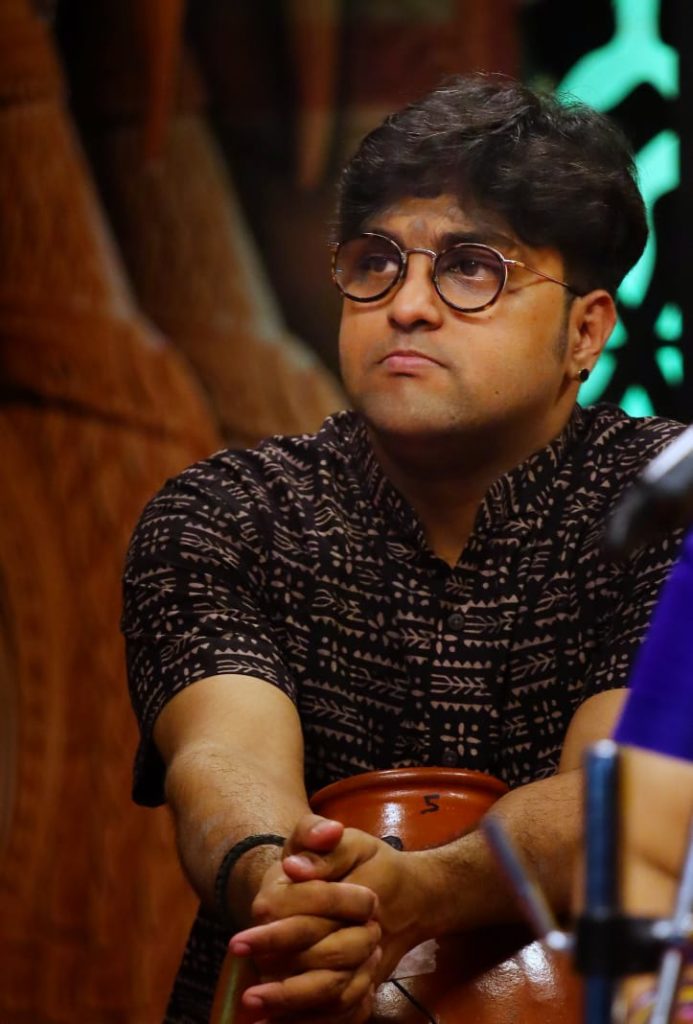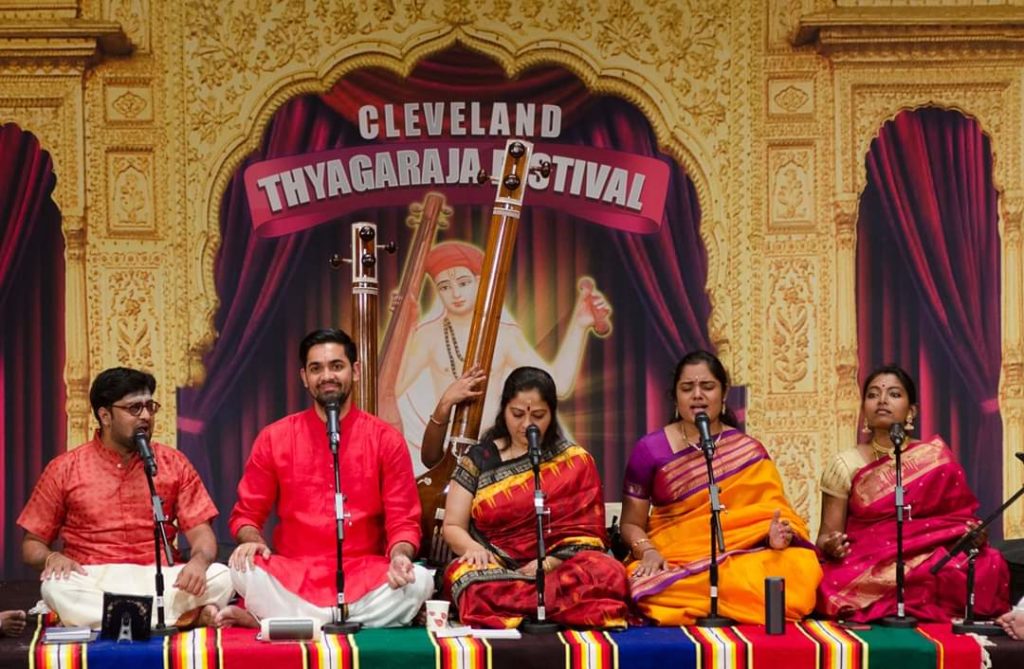G Chandrasekara Sharma
“As an excellent vocalist himself, he knows to emote according to the raga and to highlight the kriti, neraval and swaram uniquely too,” say senior musician RK Shriramkumar and senior ghatam artiste N Guruprasad. Sangita Kalanidhi designate Dr. S Sowmya adds, “As a result, he does not look at percussion in an isolated manner but raises the sheen of the entire concert. That is why even stalwarts like TN Krishnan Sir happily take him on.” Similar sentiments are expressed by others in the Carnatic fraternity about this affable, highly sought-after ghatam artiste who has 2-3 concerts daily during the music season.
A version of this article appeared in The Hindu.

G. Chandrasekara Sharma (Chandru) comes from a family steeped in music. His grandfather, TR Hari Hara Sharma, was a mridangam and morsing artiste and a fixture at Flute Mali’s concerts. He had set up the still-functioning Jaya Ganesh Tala Vadya Vidhyalaya in Triplicane. Chandru’s father, TH Gurumurthy, a violinist and a student of Sangita Kalanidhi TN Krishnan, is the younger brother of TH ‘Vikku’ Vinayakram and TH Subash Chandran, esteemed ghatam artistes.
Chandru’s training was an organic and unregimented one. Family members recollect his repeating even complicated korvai-s at age 3 or 4 itself and sitting with Vinayakram and Subash Chandran through several full concerts without fussing. He had some basic training for farhans and mohra on the mridangam and ghatam at his grandfather’s school and periodic individual lessons from Subash Chandran. At wedding concerts by the family, Chandru would be allowed to play for one piece after the tani avartanam.
As Gurumurthy had joined Annamalai University as a violin lecturer, Chandru studied in Chidambaram from Grades 5-8. There he learned vocal from RK Kumar. Chandru’s mother, Hema, a tiruppugazh exponent, was keen on Chandru pursuing vocal. However, percussion instruments were present at home since Gurumurthy had interest in layam and Chandru’s elder brother, Hari Hara Sharma, learned kanjira. Chandru used to practice whatever he knew on the ghatam for at least an hour and a half each day without requiring any prompting.
Tuning and selecting a ghatam.
Several senior artistes such as Srimushnam Raja Rao, Thiruvarur Bhaktavatsalam etc. would stay with Chandru’s family when they visited. Chandru would be asked to demonstrate some of his skills. Many of these artistes would let him sit with them at concerts and play. He would also play for some local artistes. The earliest occasion of his playing a full concert was in 5th Grade with Umayalpuram Sivaraman for a violin duet by Gurumurthy and VL Sudarshan.

Learning sessions from Subash Chandran were concentrated and chockful of information. “I did not go nearly as much as I could but, when I did, he gave me a lot to digest and practice. He would also practice the ghatam with me.” Chandru learned vocal regularly for 8 years from N Vijay Siva. He continues his training now under RK Shriramkumar.
Chandru cannot say enough about the mentoring received from more senior artistes including RK Shriramkumar, N. Guruprasad, B Ganapathyraman, B Sivaraman, TM Krishna, Sangeetha Sivakumar, KV Gopalakrishnan, K Arunprakash, BS Purushottam etc. “They took me on whenever possible, accommodating themselves for me and teaching me on stage. Besides, they constantly guided me by answering questions, attending my concerts and giving constructive feedback by pointing out errors, sharing tips and ideas all without standing on ceremony or thinking of us as juniors or competition. It was invaluable.” Chandru says that he, and his generation, hopes to continue this affectionate mentoring of other artistes.
A memorable program was ‘Pinjuratnangalin Pancharatnangal’. The brainchild of Sulochana Pattabhiraman, Chandru played the ghatam for this ensemble children’s program with 7-8 vocalists, 1 vainika, 2 violinists, 2 flautists and 2 mridangists where they had regular and intense practice to present Thyagaraja’s Pancharatna kriti-s on Doordarshan’s Podhigai channel. Most successful, the entire group toured throughout Tamil Nadu presenting this show. “This was a tremendous learning experience – I learned how to play with others for songs.” He was also part of ‘Abaswaram’ Ramjhi’s Isai Mazhalai troupe which included Rithvik Raja, Bharat Sundar, Vidya Kalyanaraman, Dharini Kalyanaraman and Anirudh Athreya. “All of us still count on each other,” says Chandru.

While in 11th grade, he got acquainted with YACM (Youth Association for Classical Music), getting into the committee while in college. “This facilitated many introductions and interactions with artistes – we would invite them for our programs and to give recitals. That was a momentous time in my life.” Chandru does not allude to his familial ties unless asked, preferring to stand on his independent merits. Some awards he has received are Bharat Kalachar’s Yuva Kala Bharathi and Krishna Gana Sabha’s TR Hari Hara Sharma awards.

His first senior concert was at age 17 for Shertalai Renganatha Sharma in 2007 for Kalarasana followed soon after by TM Krishna in Tirupati with RK Shriramkumar, Poongulam Subramaniam and Anirudh Athreya. He mentions vocalist Rithvik Raja who exposed Chandru to several recordings of yesteryear stalwarts. “In his car, he would always have a renowned master’s Carnatic recording playing. He has exposed me to so much good music.” Chandru’s awareness from this copious listening is so acute that he can distinguish who the percussion artiste is just by the ear. “When I listen, my focus automatically goes to the percussion. When do they join in? How do they play for neraval and swaram? How do they accent a particular juncture?” Besides Vinayakram, Chandru has been inspired by Dr. S. Karthick – “I have heard from so many that few can play for neraval and swaram-s as well as the two of them do.”
Sri. Vijay Natesan on mridangam.
Guruprasad says, “Chandru adapts and supports all the co-artistes impeccably. As a ghatam artiste, he has to play with different styles of mridangam as well. He gets along with everyone, seniors or juniors and adapts to each mridangist’s style using excellent ghatam fingering.” K. Bharat Sundar adds, “He is incredibly apt in his accompanying.”
Shriramkumar says, “Chandru has music innately within him and his passion and involvement is a very special quality. Traditionally, the ghatam has been subservient to the mridangam but when Chandru and his ilk play, it takes a complimentary role, be it ‘koriappu’ or ‘kanakku’ or playing alongside.” Chandru has played with all senior mridangists including TK Murthy, Umayalpuram Sivaraman, Trichy Sankaran, Kamalakar Rao, Guruvayur Dorai and more.
Chandru had a different opportunity recently, playing for vocalist Ramakrishnan Murthy with Vittal Rangan on violin and NC Bharadwaj on mridangam. There were two tani avartanam-s – one played entirely on the mridangam by Bharadwaj and the other, from start to finish, on the ghatam, by Chandru.
Using the leg
for more tones.
Listening to the old masters is a vital part of training, enhancing and sharpening musical knowledge. Upapakkavadyam artistes suffer a major disadvantage here. There are few old recordings of upapakkavadyam played by itself for pieces. Until fairly recently, even the violin interludes were usually accented by the mridangist (the longest ones often still are). These artistes, therefore, have far less of a repository to refer to. “Though the underlying content is the same for all Carnatic percussion instruments, it requires very different fingering techniques to produce sound since the instruments themselves are so dissimilar.”
Unlike the mridangam or the kanjira, the ghatam does not offer the resonance resulting from vibration within the instrument. Therefore, specific know-how has been utilized that employs the opening of the instrument in conjunction with the distance to the stomach, carefully calibrated by movement of the instrument using the leg. There is a ‘stomach ghumki’ and an ‘open ghumki’ – Chandru’s uncle, Vinayakram, employed these in a pathbreaking manner. In fact, most ghatam players used to play the instrument with their shirts unbuttoned, since even a layer of fabric could alter the sound quality. More advanced microphones have perhaps eliminated this tradition. Chandru also explains that the sound produced on the instrument is more refined technique than force applied with the fingers – something not obvious to the lay person.
Making ghatams is a highly skilled and labour intensive process. They are not just pots. The clay is reinforced with other ingredients for tonal quality and hand massaged and patted hundreds of times to ensure a completely smooth and uniform surface. Most are made by one family in Manamadurai.
The process of selecting one goes through careful iterations. “Once informed that a batch of ghatams (often 100-150) has been made, we first check for uniformity of sound throughout the instrument. We then examine those selected for what sruti it is in. Some might have excellent tone but will be at an odd sruti, for example. We will then try the feel of the instrument and pick what is comfortable to our hands – each artiste has preferences – some like it very hard, some not so much, for example. We then make our final selections.” A little-known fact is that the ghatam’s sruti too changes. Higher temperatures raise it and higher humidity lowers it. Adjusting it requires finesse – playing clay is carefully applied with some water to lower the sruti slightly. If more lowering is required, the instrument can be filled with water to a certain level and air dried. It is important, however, that any clay and moisture is removed as soon as possible after playing, as these can affect tonal quality permanently.
On fingering intricacies.
Shriramkumar says, “A ghatam has a very sharp tone making sruti alignment particularly critical. Chandru brings his ghatams set perfectly to sruti. Vinayakram mama has done tremendous service here by imparting the importance of that sruti suddham.” Shriramkumar recollects how Vinayakram would have a ghatam marked as MSS – “Set so perfectly to MS amma’s sruti, it was such a pleasure to listen to the consonance between it and the tanpura.”
“He knows where he should play in tandem and where an opposite effect might better accent. He will play only appropriately where the ghatam will enhance and abstain where it does not. This a key reason why G Chandrasekara Sharma is so appreciated by mridangists too,” concludes Sowmya.
Many thanks to Sri. Chandrasekara Sharma who supplied the old photos and facilitated much of the media for this page on short notice. Thanks are also due to Sri. Rajappane Raju and Sri. Ramanathan N Iyer who promptly provided recent photographs.
Awesome interview and covered fully about Chandrasekara Sharma.